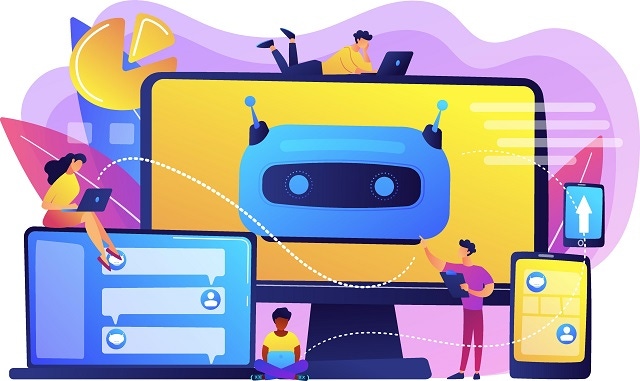How We’re Doing on Humanizing the Digital Experience
A lot of time, effort, and money has been spent on humanizing the digital experience. So how are we doing so far? Here’s a look at some of the shiniest and dullest examples along the way.

Humanizing the digital experience is much harder than it sounds because it involves much more than just putting a happy face on software. First companies must figure out what humanizing means and then they have to turn that into a convincing reality. The results so far have been mixed but interesting.
That’s understandable considering how easy it is to get tangled in the details. After all, trying to please millions of customers on an individual basis is quite the challenge.
“Companies are struggling with customization vs. standardization when it comes to engaging with customers. Standardization allows you to scale and automate processes. However, each customer is different in how they want to interact with companies and brands as well as their own individual perception of that brand and their needs, meaning what they perceive is valuable,” explains Ari Lightman, professor of digital media at Carnegie Mellon University's Heinz College.
A great deal is at stake, and it isn’t limited to profits. It’s in support of the organization’s survival, too.
“With the Great Resignation accelerating digital transformation in the workspace, companies are more reliant on robots now than ever before. The emergence of conversational AI and intelligent automation has enhanced the customer experience by humanizing the digital experience,” says Theresa Kushner, data and analytics practice lead at NTT DATA Services.
Kushner says, “conversational AI has quickly grown into a company concierge,” since it is used primarily to support customer-company interaction.
But others say that automation is falling short of providing anything remotely reminiscent of a human experience.
“A dependency on chatbots and automation tools to digitally provide solutions to customers [typically means] they are hastily done and without regard for how humans may react with them. This ultimately creates frustration for customers,” says Imran Riaz, vice president, head of UX practice at SystemSoft Technologies, a consultancy and provider of IT managed services.
If perchance a company does find the perfect balance between scaling and personalizing, there are still plenty of intricacies to figure out.
Here are some highlights from progress made so far and the work yet to be done in several areas:
Finance industry in its humanizing quest
“Banks and financial institutions are increasingly looking towards third parties to expand their digital capabilities. Many financial institutions have focused on upgrading their user interface but using white label technologies which do not personalize the experience in a way that matters to customers. Tailored experiences and meaningful recommendations delivered at the moment of need are key,” says German Pugliese-Bassi, Co-Founder and CMO of Technisys, a digital banking platform provider.
And now a look at what one bank is working on now.
“At Bank of America, we leverage data, AI, and business intelligence to create individualized experiences that work for each client, no matter where they are in their financial journey. Our capabilities allow us to go beyond providing one singular digital journey, and instead provide a dynamic journey for each of our more than 54 million verified digital clients,” says Nikki Katz, Head of Digital at Bank of America.
Katz cited the bank’s virtual assistant, Erica, as an example of the advanced deliveries of personalized services. Erica delivers proactive analytics based on saving and spending activity, changes in monthly bills, rewards eligibility, and other financial insights to customers on a personal basis.
Humanizing in the hiring process
“If we’re looking at recruitment specifically, we notice that recruiters often only look at the first part of the process, the application itself, when attempting to make the candidate experience more human,” says Steve Martin, CTO of Harver, a volume hiring product provider for hourly roles for clients like McDonald's, Chili's Rituals, and Scotch & Soda.
“They try to make the rest of the application process more human through conversational tools such as chatbots, but it ends up feeling very transactional and mechanical. When the process is only partially automated, candidates can be left hanging for days, or never even hear back from the recruiter,” Martin adds.
And a peek at the work that lies ahead.
Martin says that companies that understand that the hiring process is part of the employee experience “are updating their process so that candidates can receive information about the company and get to virtually experience the job before submitting an application.”
Typically, this is accomplished through “a combination of tactics, such as employer-branded videos, virtual job tryouts, and video interviews, where candidates get to see a real person, as opposed to just interacting with a chatbot. Meanwhile, the tasks that don’t require human interaction are automated, like screening, interview scheduling, and candidate auto-progression.”
Where healthcare stands on humanizing efforts
“Healthcare has the unique challenge of requiring personalization from at least two perspectives: the patient and the physician. Each patient has their own care history and goals. Each physician has their own expertise and way of working. To date, healthcare has struggled along both axes,” says Jonah May, director of product at Sirona Medical, a producer of a unified platform for radiology IT applications.
“Patients more recently are adopting human-centered digital experiences, through mental health apps, digital therapeutics, and so on, but providers of care still are using antiquated software systems,” May adds.
Most patient portals are sorely in need of a makeover because the healthcare industry has “hit a wall with bandage solutions,” according to May.
However, progress is being made on the physician side of things. After all, they are humans too.
“We are beginning to see more software solutions built for and by doctors that are entirely in the cloud, allowing them to see and/or diagnose a greater number of patients, more efficiently and provide better patient care,” May says.
May also reports that cloud-based AI is dampening noisy data and creating experiences that physicians can count on.
“There’s also been progress in the unification of fragmented applications to create a cohesive and reliable experience for physicians,” May says.
Humanizing efforts in technology
Specifically in the leading technology in humanizing efforts: chatbots. Seems they’re up for a facelift and an upgrade already.
“Most virtual assistants that consumers will interact with today are fairly limited. You tell it, ‘I lost my password’ and more than likely it gives you a phone number to call or a webpage to go to next. A more powerful virtual assistant could authenticate people or help them reset a password. The missed opportunity is not going to that next level where the virtual assistant is not just providing information, but actually helping people execute tasks that simplify their day-to-day lives,” says Seth Dobrin, chief AI officer at IBM.
AI clearly needs more reasoning ability. Researchers are working on developing that but it’s easier said than done.
“But a newer, more hybrid approach to AI is beginning to bridge that gap. Neuro-symbolic learning (NSL) combines the strengths of neural networks and classical symbolic AI to accomplish complex tasks that neither of these methods can perform individually,” Dobrin says.
Mapping the language to the data elements like chatbots do now is relatively simple. “However, a hybrid approach to AI like NSL is needed to inject reason into producing more complex and actionable results,” Dobrin says.
But the technology industry is also working on other aspects in humanizing the digital experience, too.
“So far, Microsoft has made some progress with initiatives like reducing the number of steps required to complete tasks, making interfaces easier to use, and providing more personalized experiences. In addition, there are a number of startups that are working on solutions to make the digital experience more human-centric. Some examples include Emotion AI, which captures and analyzes emotions through facial expressions and body language," says Morshed Alam, founder & editor at Savvy Programmer.
Future in Humanizing Tech
While most of the action today focuses on humanizing user interfaces and other consumer touchpoints, plans for more extensive experiences are also already in the works in some sectors.
“One of the fascinating new developments is the use of the blockchain and NFTs. We are early on the adoption of Web 3.0/experiential economy/tokenized web but providing a customized experience for a consumer on top of the product or service purchased has real value,” says Carnegie Mellon’s Lightman.
He cites as an example Alfa Romeo’s launch of an NFT associated with their new SUV. It provides a digital service record for the vehicle that resides on the blockchain. Interestingly, other vehicle manufacturers are following suit. For example, Acura offers an NFT as does Lamborghini.
“That is valuable to a lot of owners who want a vetted service record associated with the transfer of the vehicle to another owner. It might even increase the value associated with the vehicle for resale,” says Lightman.
The human experience is broadening on the virtual front, but whether it will be truly humanized, meaning connected on an emotionally intuitive and reactive level, is likely an ongoing challenge.
What to Read Next:
Enterprise Guide to Robotic Process Automation
About the Author(s)
You May Also Like







